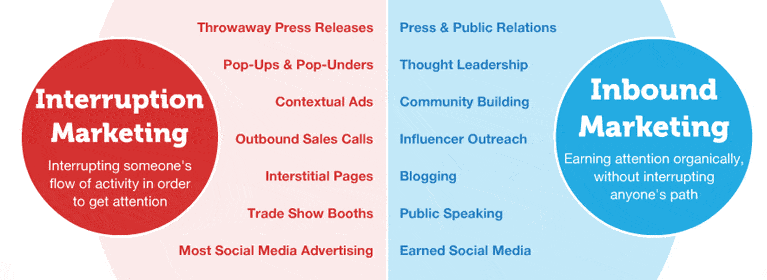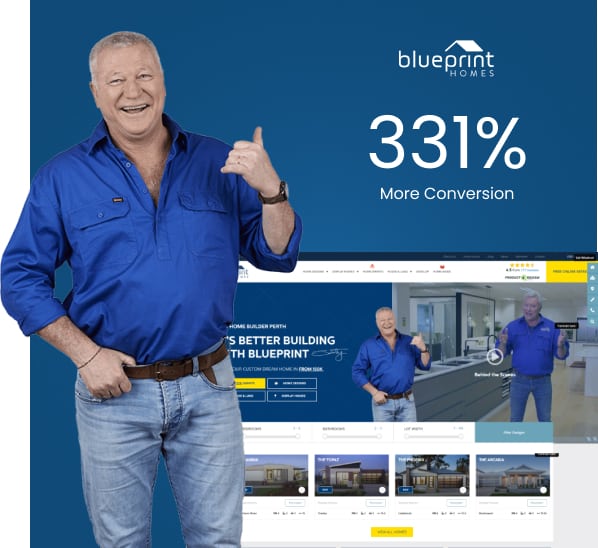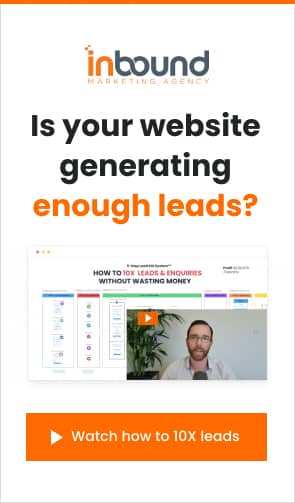Do you wish you had the budget to advertise your business on TV? If you are thinking about using traditional outbound marketing (TV, radio, billboards, telemarketing, newspaper etc.) to promote your business, it might not be right for you. Inbound marketing, however, (Blogs, SEO, PPC, Email, Social etc.) might be a better option.
What’s the difference (inbound vs outbound marketing)? This article will explain each type of marketing to help you choose which one is right for your business.
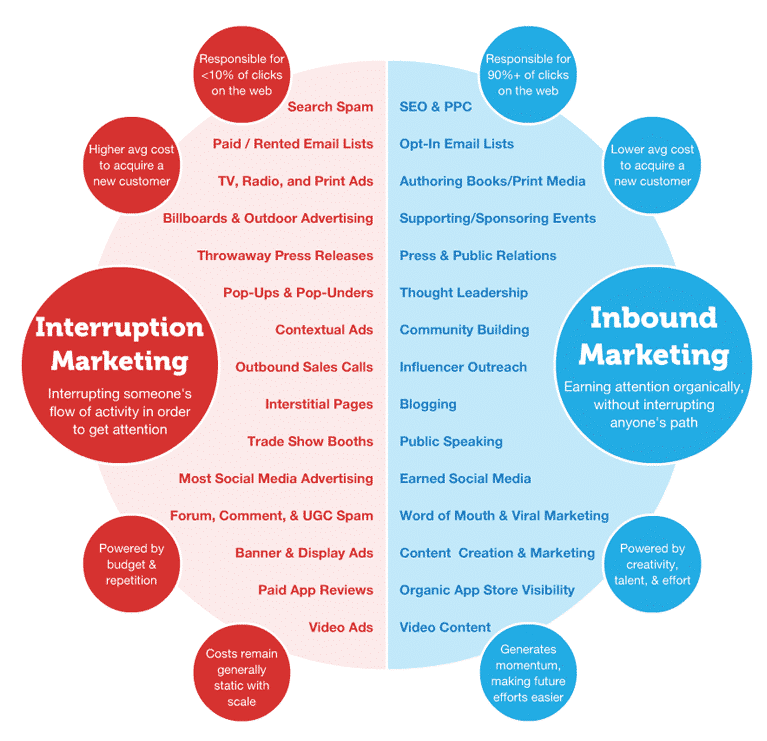
Source: Moz
Inbound marketing, as the word inbound suggests, is about attracting potential customers to your business through earning—rather than buying—their attention. It relies on digital interaction through content-driven means such as email marketing, blog posts, podcasts, white papers, infographics, ebooks, remarketing/retargeting and successful social media campaigns. As content is shared, your website will experience an increase in search engine rankings, referral traffic and potential leads.
In contrast, outbound marketing is about reaching out to potential customers to convince them they need your product or service. Outbound marketing focuses on a hard sales approach. It uses traditional marketing tactics like advertisements and cold-calling to generate leads.
Cost
In simple terms, outbound marketing costs more and gives less (than inbound marketing).
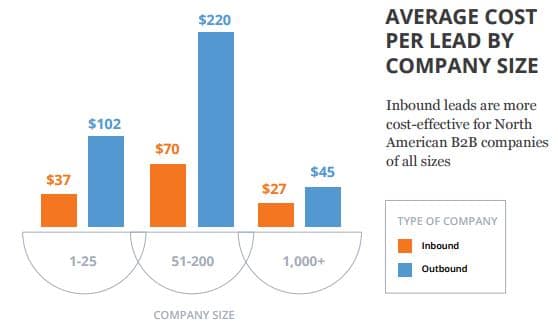
Source: State of Inbound
Why? Because people do not respond to a blanket bombardment of seductive offers as well as they do to a conversation, which is present in inbound marketing.
The graph by State of Inbound Marketing, found “inbound marketing costs at least 67% less per lead than traditional marketing”.
Due to a low conversion rate from these more traditional outbound methods of marketing, the Return on Investment (ROI) is lower than with inbound marketing tactics.
Inbound marketing focuses on a two-way conversation with potential customers, it eliminates the need for expensive TV advertising or Internet banner ads and thus has higher ROI.
Time
Now that you may feel convinced that inbound marketing is the way to go because of higher ROI, let us look at the time it takes to see the results from your marketing campaigns.
Over the past few years, you’ll notice businesses are spending less on outbound marketing, due to the ROI, see graph below:
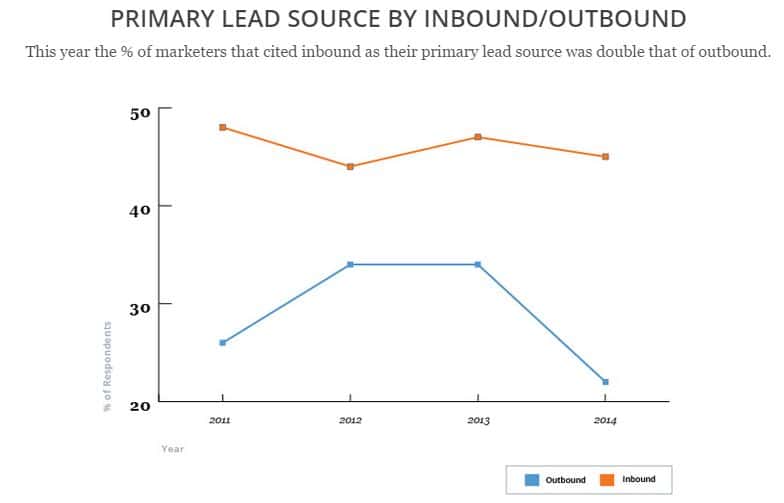
Source: State of Inbound
When an outbound marketing campaign is successful, its reach and results are fairly immediate. Likewise, it is quickly apparent when an advertisement or cold-calling campaign flops. The opposite is true as well: when you stop your outbound marketing campaign, you might disappear from the hearts and minds of your potential customers very quickly.
The success of an inbound marketing campaign, however, is often not immediately apparent because it can take time to create appropriate media and for the content you create to be recognised by search engines. We inform our clients that inbound marketing is not an overnight cure, as it generally takes a few months to yield a ROI, but you will never look back.
It also takes time for your potential customers to get to know you and form a relationship with you, which—only eventually—might become profitable for your company. The quality and longevity of this relationship and of the content you generate is key to the success of inbound marketing.
Now that we understand some main differences between the two approaches to marketing, let us delve into their specifics, highlighting pros and cons for each.
It is worth considering that “…57% of the sales cycle is complete before a prospect reaches out to a sales rep.” Digital Evolution, Conference Executive Board, 2012. Inbound marketing assists with lead nurturing, which is likely to nurture your leads across the line.
Inbound Marketing
The phrase inbound marketing was coined by HubSpot CEO and founder Brian Halligan in 2005. That should tell how (relatively) new it is. Indeed, because of its rejection of many outmoded forms of advertisements (such as print flyers) and its embrace of current trends in social media, inbound marketing is considered a “new school” approach.
Effectively, inbound marketing’s goal is for your business to be found by your potential customers.
How does inbound marketing work?
An inbound marketing strategy utilises an interactive form of marketing that focuses on engaging with consumers who are already seeking out information about the type of products or services you are offering. It relies heavily on what Seth Godin calls permission marketing.
Aptly named, permission marketing is driven by consent online users give to companies to market their products or services to them. As you can imagine, it is much easier to have those who already said yes to you once to say yes to you again at some point.
But why would users give their consent to being marketed to?
Because they get something very valuable in return. It might be an blog article that addresses an issue someone is facing, a white paper that educates them about something they seek to understand or an e-book that provides solutions to the their problems.
The users can also participate in a conversation with you about topics within your area of expertise via email, blog commenting, forums and all forms of social media (Facebook, Twitter, Instagram, Pinterest. Etc.).
The Big 3: Search Engine Optimisation (SEO), Content & Social
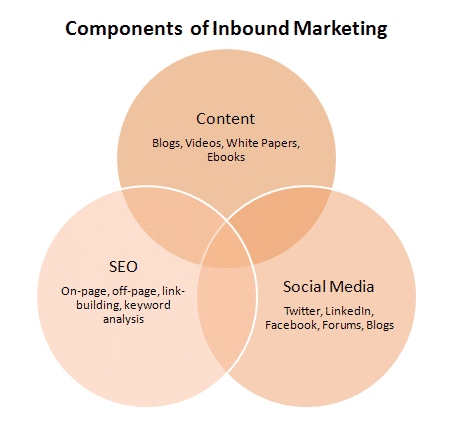
Source: Hubspot
Of course, to let people know you have the information they are looking for, you will need to appear where they are searching. In most cases, Google will be the first place people look, so you will need to do your best to appear within those results.
Together, content, social media and SEO comprise the components of inbound marketing.
Pros
While certain types of inbound marketing—such as creating ebooks or white papers—might initially be time-consuming, their ROI is very high. As these documents are shared over various social media channels (some can even go viral!), their reach increases with very little effort on the part of their creators.
The content-rich nature of inbound marketing also means better brand recognition. By filling your website with articles about your niche, you position yourself as an industry expert to consumers searching on this topic. The best part of inbound marketing is that the relationship you establish with your readers and/or followers has potential longevity and can be capitalised on for years to come.
Cons
You will need a website with specific functionality, such as a blog section, email subscription etc., however do not let this stop you. It might take time for the search engines to start ranking your content in their results’ pages high enough for it to be noticed. You also have to establish a decent following on social media for your content to be shared widely. All of it takes time and a lot of effort.
Want to learn more about SEO? Read our SEO Strategy Guide for 2017/18
Outbound Marketing
Outbound marketing has been around for a long time, and if you have ever watched TV, listened to the radio, read a newspaper, received a marketing phone call, saw a flyer, or drove by a billboard, you have been the recipient of it.
The video below mocks outbound marketing, but it is quite an entertaining video to watch:
Ultimately, outbound marketing’s goal is to find potential customers for your business.
How does it work?
It relies on sending out blasts of information to large audiences in hopes of getting responses.
Although outbound marketing efforts are harder to track and they tend to yield lower ROI relative to inbound marketing, it is common for an organization to allocate up to 90% of its marketing budget to this form of marketing.
Pros
If it is not new and hip, does it mean outbound marketing is obsolete?
Despite criticisms, outbound marketing has some good reasons why it still accounts for a big portion of corporate marketing efforts.
In 2013, for example, DiscoverOrg conducted a study of 1,000 IT professionals that revealed the effectiveness of cold calling. According to their study, 65% of respondents said cold calling or emailing “led to an IT vendor’s being evaluated”, and 75% said, “they’d decided to attend an event or take an appointment after having received a cold call or email”.
Cold calling is just one of many approaches that can be used within an outbound marketing campaign. These campaigns allow marketers to scale their efforts on a case-by-case basis by choosing different outbound marketing techniques, according to their audience and budget.
Cons
Companies utilising outbound marketing today are faced with several problems. If you employ outbound marketing, you will:
- Find it difficult to track your return on investment (ROI).
You will not know how many people have seen your flyer or a print advertisement before they are recycled. - Face blocking techniques.
As consumers get more savvy, they are increasingly able to limit their exposure to advertising through techniques such as the do not call lists, spam filters and use of TiVo, for example. - Have to accept the high cost, low yield ratio of your campaigns.
Conclusion
My Winner = Inbound Marketing
If I want something, I will search for it. Do not interrupt me.
If you want my money, earn my trust and help me, do not sell to me!
Do you put in the time and effort, along with a reasonable amount of money, into relationships?
ALTERNATIVELY,
Do you go for a quick, but expensive, gain that will allow you to approach consumers about a product they might not even know they want?
Perhaps your answer lies somewhere in the middle.
Now that you know the differences between inbound and outbound marketing, what do you think would work for your company?
If you are looking for an inbound marketing strategy, we offer businesses a free inbound marketing audit. It will include a competitor gap analysis, traffic analysis and keyword performance, which will help identify your business’s strengths and weakness. Feel free to contact us for more information.
Want to learn more about inbound marketing? Check out the 7 Lies Perth SEO Companies Might Say

